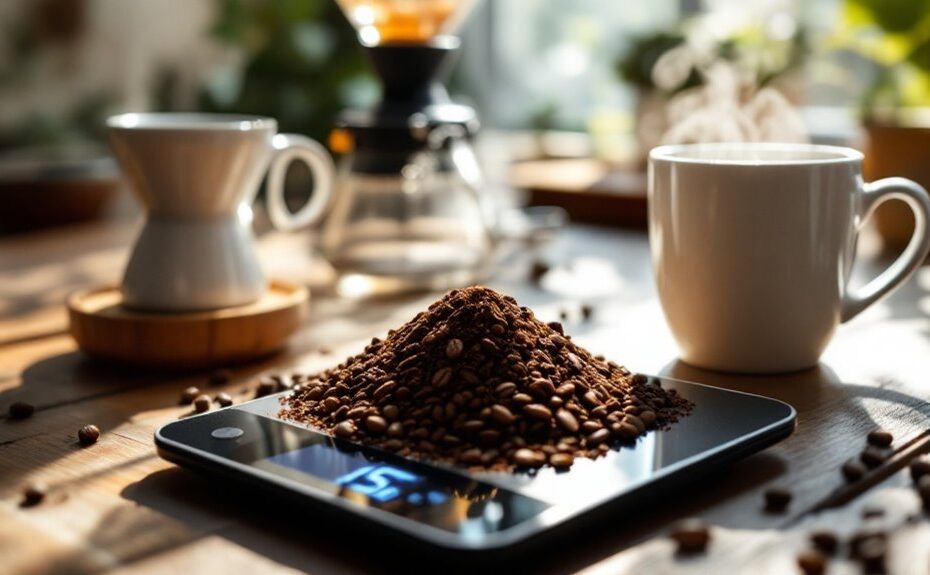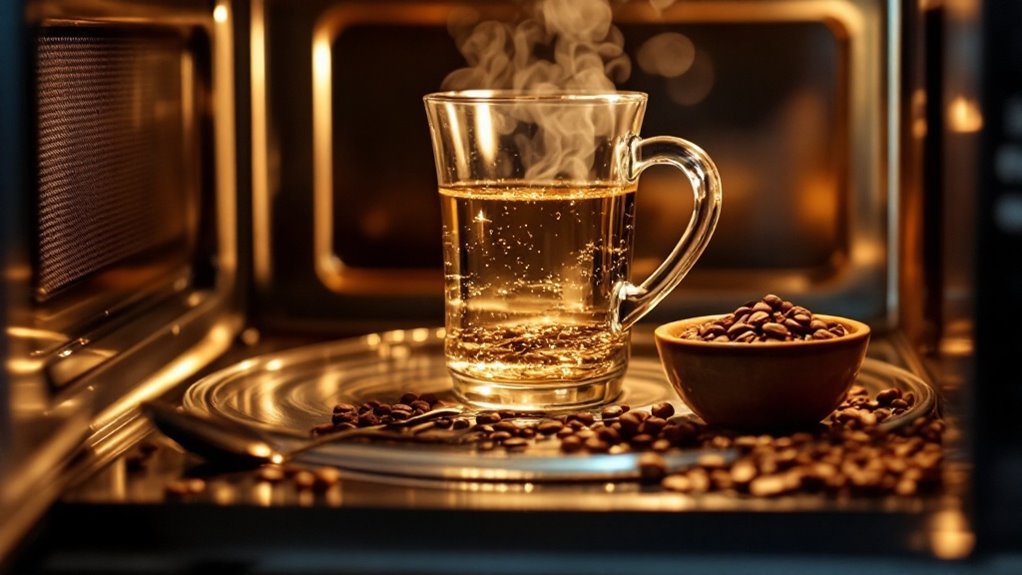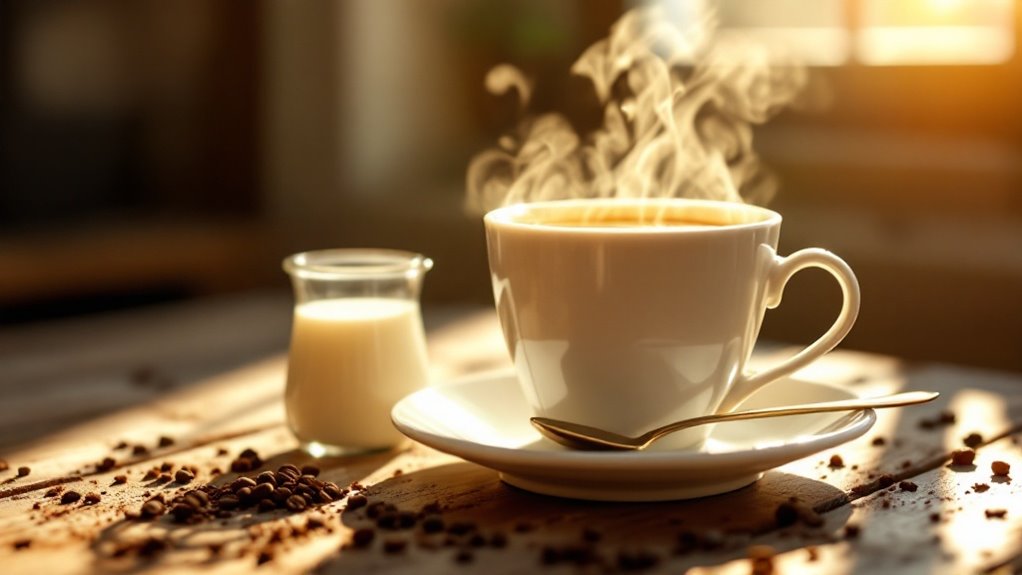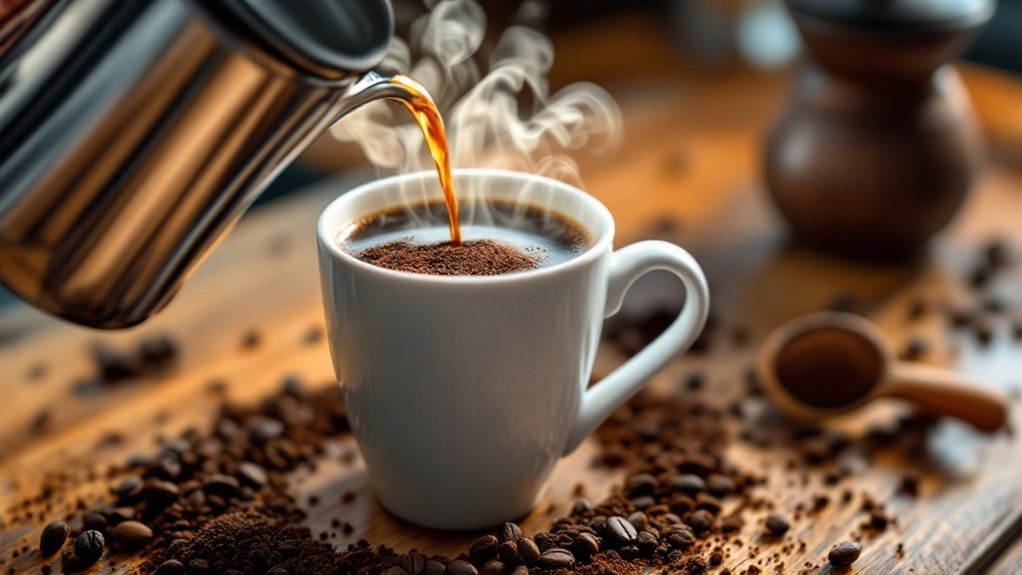







The art of brewing coffee is like balancing a scale—too little, and you're left with a hollow taste; too much, and bitterness takes over. You've probably wondered how much coffee to use per cup, but the answer isn't as simple as a single measurement. Factors like grind size, brewing method, and personal preference all play a role in crafting your perfect cup. Whether you're using tablespoons or a scale, the key lies in understanding the balance between coffee and water. So, how do you find that sweet spot? The journey starts with a few simple principles.
Key Takeaways
- Use 1 tablespoon (5 grams) of ground coffee per 6-ounce cup for a balanced brew, following the standard 1:16 coffee-to-water ratio.
- For stronger coffee, adjust the ratio to 1:15 (1.5 tablespoons per 6 ounces); for lighter coffee, use 1:18 (1 tablespoon per 8 ounces).
- A standard coffee scoop (2 tablespoons or 10 grams) is ideal for brewing a 6-ounce cup, ensuring consistent strength and flavor.
- For multiple cups, calculate 8.3 grams of coffee per cup (e.g., 83 grams for 10 cups or 16 tablespoons).
- Use a digital scale for precision, as weight-based measurements eliminate inconsistencies caused by grind size or density variations.
Defining a Standard Coffee Cup
When brewing coffee, it's important to know what a "standard coffee cup" actually means. A standard coffee cup is defined as 5 fluid ounces (150 milliliters) by most coffee machine manufacturers. This measurement differs from the 8-ounce baking cup commonly used in recipes, which can lead to confusion if you're not careful. In the U.S., coffee makers and carafes are designed with this 5-ounce standard in mind, so a 12-cup machine will produce about 60 ounces of brewed coffee. Always check the markings on your carafe to verify accurate measurements, as physical mugs can vary widely in size and don't always align with the standard.
The 5-ounce standard originates from coffee brewing traditions, while the 6-ounce cup size was inherited from tea measurements. These precise measurements matter because they directly impact the strength and flavor profile of your coffee. If you use a larger mug without adjusting your coffee-to-water ratio, you'll end up with a weaker brew. Stick to the 5-ounce standard when measuring water and coffee grounds to maintain consistency and achieve the intended flavor. Your carafe's markings are your best guide for brewing the perfect cup.
Understanding Coffee-to-Water Ratios
Start with a 1:16 coffee-to-water ratio for drip coffee, using 1 gram of coffee per 16 milliliters of water for a balanced flavor. Adjust the ratio to 1:15 for a stronger brew or 1:18 for a lighter cup, depending on your taste preferences. For cold brew, use a higher ratio between 1:10 and 1:15 to account for the extended extraction time.
Ideal Brewing Ratios
To nail the perfect cup, you'll need to get the coffee-to-water ratio just right. The Specialty Coffee Association recommends a Golden Ratio of 55 grams of coffee per liter of water (±10%), which translates to roughly 1:18—1 gram of coffee for every 18 mL of water. This ratio guarantees balanced extraction, highlighting the coffee's flavor profile without over-extracting bitterness or under-extracting acidity. For a stronger brew, tighten the ratio to 1:15, using 1 gram of coffee per 15 mL of water. Conversely, a lighter brew works well at 1:17 or 1:20. Adjusting the ratio impacts the brewing process, so stick to precise measurements for consistency. Espresso, however, demands a concentrated 1:2 ratio—18 grams of coffee yields 36 grams of liquid—for its signature intensity. Cold brew requires a higher coffee-to-water ratio, typically 1:10 to 1:15, due to its extended extraction time. By mastering these ratios, you'll optimize your brewing process and reveal the full potential of your coffee.
Adjusting for Taste Preferences
While the Golden Ratio of 1:18 provides a balanced starting point, your personal taste preferences play a key role in refining your coffee-to-water ratio. If you prefer a stronger, bolder coffee flavor, adjust the ratio to 1:15 by using 12 grams of coffee for a 6-ounce cup. For a milder, lighter brew, try a 1:20 ratio with 8 grams of coffee. Experimenting within the 1:15 to 1:18 range helps you find the ideal coffee strength, acidity, and body for your perfect cup. Cold brew requires a higher coffee-to-water ratio, typically 1:10 to 1:13, due to its extended extraction time and lower brewing temperature. Espresso, on the other hand, uses a concentrated 1:2 ratio for a rich, intense flavor. The quality of your coffee also influences the ratio; freshly ground beans often yield a more pronounced flavor, so you might use slightly less coffee. By fine-tuning your coffee-to-water ratio, you can consistently brew a great cup tailored to your taste. Remember, precision in measurements and brewing techniques guarantees the best results.
Measuring Coffee With Tablespoons
Measuring coffee with tablespoons is a straightforward method that many home brewers rely on for its simplicity. One tablespoon of ground coffee typically equals about 5 grams, which is ideal for a 6-ounce cup. For a standard 8-ounce cup, you'll need 1.5 to 2 tablespoons, depending on how strong you like your brew. If you prefer a richer flavor, aim for the higher end of this range. A level tablespoon guarantees consistency, while a heaped tablespoon can add up to 7-8 grams of coffee, potentially altering the flavor profile. Two tablespoons of ground coffee weigh approximately 10.6 grams, aligning with the Golden Ratio of 1:16 (coffee to water) for a 6-ounce cup. This ratio is a great starting point for balanced extraction and flavor. While measuring with tablespoons is less precise than using a scale, it's a practical approach for everyday brewing. Just remember to adjust based on your cup size and taste preferences to achieve the perfect brew.
Using Scales for Precise Measurements
Using a digital kitchen scale takes the guesswork out of measuring coffee, guaranteeing you hit the perfect balance every time. By weighing your grams of ground coffee, you achieve precision that volume measurements can't match. For the Golden Cup standard, aim for a coffee-to-water ratio of 1:18, meaning 10 grams of coffee for every 180 grams of water. This Golden Ratio secures a balanced extraction, highlighting the coffee's flavor profile without over- or under-extraction. A digital kitchen scale lets you measure both grams of coffee and grams of water accurately, eliminating inconsistencies caused by grind size or density variations. Whether you're brewing a single cup or scaling up for multiple servings, a scale guarantees your coffee-to-water ratio stays consistent. This precision is especially vital when experimenting with different brewing techniques, as even slight deviations can alter the taste. By relying on weight rather than volume, you'll craft a consistently delicious cup every time, revealing the full potential of your coffee beans.
Brewing Methods and Their Ratios
To achieve the best flavor from your coffee, it's essential to match your brewing method with the right coffee-to-water ratio. For drip coffee, use 10.6 grams (2 tablespoons) of ground coffee per 6 ounces of water, adhering to a 1:15 to 1:18 ratio for brewing. This method produces a balanced, clean cup with medium body. If you prefer a richer, fuller-bodied brew, try the French press. Use a coarser grind and a 1:12 to 1:15 ratio, steeping for 4 minutes. This brew method extracts bold flavors and oils, creating a robust profile. For espresso, aim for a 1:2 ratio, using 18 grams of finely ground coffee to yield 36 grams of liquid in 25-30 seconds. Cold brew requires a higher concentration, with ratios ranging from 1:10 to 1:15, steeped for 12-24 hours. Pour-over methods like V60 or Chemex use a 1:16 to 1:17 ratio, with medium-fine grounds and a brew time of 2.5-4 minutes, resulting in a bright, nuanced cup. Adjust your ground coffee per ounces of water based on your chosen brew method to reveal the ideal flavor profile.
Adjusting Ratios for Personal Taste
Finding your perfect coffee-to-water ratio is a balance of precision and personal preference. Start with the standard ratio of 1-2 tablespoons of ground coffee per 6 ounces of water, then tweak it to match your taste. If you prefer a stronger brew, increase the ratio to 2.5 tablespoons of coffee per 6 ounces of water. For a milder flavor, reduce it to 1 tablespoon per 6 ounces. Experiment with ratios between 1:15 and 1:18 (coffee to water) to fine-tune the strength and flavor profile. Keep in mind that the grind size and brewing method also influence the final taste, so adjust accordingly. To track your preferences, maintain a brewing journal where you note the ratios, grind settings, and brewing techniques you try. This helps you identify the ideal balance for different coffee types and methods. Remember, there's no one-size-fits-all ratio—your perfect cup depends on your unique preference for strength and flavor.
Coffee Scoop Basics and Usage
A standard coffee scoop measures 2 tablespoons of ground coffee, ensuring consistent strength when brewing. You'll typically use one leveled scoop per cup listed on your coffee maker to maintain the ideal coffee-to-water ratio. For a 10-cup pot, you'll need 10 scoops, as this measurement directly aligns with the machine's capacity.
Coffee Scoop Measurements
Using a standard coffee scoop guarantees consistent measurements for brewing, as it typically holds 2 tablespoons (10 grams) of ground coffee. This precise measurement secures you use the right amount of coffee to achieve balanced flavor profiles. For a single 6-ounce cup of coffee, one level scoop is ideal. If you're brewing multiple cups, adjust the number of scoops accordingly—for example, 12 scoops (24 tablespoons) for a 12-cup coffee maker. Always level the coffee scoop to avoid heaping, which can lead to over-extraction and bitterness. A standard coffee scoop is designed specifically for coffee, unlike regular tablespoons, which may vary in size and lead to inconsistent results. By sticking to this method, you'll maintain the correct coffee-to-water ratio, enhancing the overall taste of your brew. Whether you're making one cup or several, using a coffee scoop guarantees you measure the exact tablespoons of ground coffee needed for the number of cups you plan to serve. This approach simplifies the process and helps you achieve a consistently satisfying cup every time.
Scoop-to-Cup Ratio Guide
To nail the perfect brew, you'll want to stick to the scoop-to-cup ratio that guarantees balanced flavor and strength. For a standard cup of coffee, use one scoop of coffee grounds, which equals 2 tablespoons, per 6 ounces of water. This ratio secures a rich, full-bodied flavor without overpowering bitterness. If you're using a 12-cup coffee pot, you'll need 12 scoops (24 tablespoons) of coffee grounds to brew approximately 60 ounces of brewed coffee. Similarly, a 10-cup coffee maker requires 10 scoops (20 tablespoons) of coffee grounds to produce around 50 ounces of coffee. Always measure your scoops of coffee leveled, not heaped, to maintain consistency in strength and avoid over-extraction. Coffee scoops are specifically calibrated for this purpose, so don't substitute them with standard tablespoons. By following this scoop-to-cup ratio, you'll achieve a well-balanced brew every time, whether you're making a single cup or filling a large coffee pot. Adjust the amount of coffee needed slightly based on your taste preferences, but this ratio is a reliable starting point for peak flavor profiles.
Calculating Coffee for Multiple Cups
Brewing coffee for multiple cups requires precise measurements to maintain the ideal flavor profile. To achieve the perfect coffee, you'll need to calculate the amount of coffee grounds per cup based on the Golden Ratio, which recommends 8.3 grams of coffee beans per cup. For 4 cups, use 33.2 grams (6.4 tablespoons) of much ground coffee. If you're brewing 8 cups, measure 67 grams (12.8 tablespoons) of grounds per batch. A 10-cup pot requires 83 grams (16 tablespoons) of coffee grounds, while 12 cups demand 100 grams (19.2 tablespoons). Multiply the standard 8.3 grams by the number of cups to determine the total amount of coffee grounds needed. This guarantees consistent strength and avoids over- or under-extraction, which can alter the flavor profile. Precision is key—whether you're using a scale or tablespoons, stick to the recommended ratios. By carefully measuring the amount of coffee grounds per cup, you'll maintain the balance and richness that define the perfect coffee experience.
Tips for Consistent Coffee Brewing
Consistency in coffee brewing starts with accurate measurements and attention to detail. Use a kitchen scale to measure your coffee grounds, aiming for 10 grams per 6-ounce cup. This guarantees you maintain a consistent coffee-to-water ratio, typically between 1:15 and 1:18, which is key to balanced flavor extraction. Always grind your coffee beans just before brewing to preserve freshness and avoid stale flavors. The grind size should match your brewing method—coarser for French press, finer for espresso—and adjust it to fine-tune your flavor profile. Pay attention to brewing time, as over-extraction can lead to bitterness, while under-extraction results in weak coffee. Clean your coffee maker regularly to prevent mineral buildup, which can affect both taste and brewing efficiency. By controlling these variables—gram of coffee per cup, grind size, brewing time, and equipment maintenance—you'll achieve a consistently delicious brew every time. Experiment with small adjustments to find the perfect balance for your palate.
Disclosure: As an Amazon Associate, I earn from qualifying purchases.






